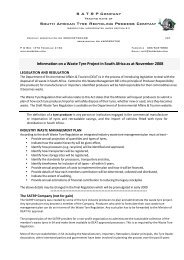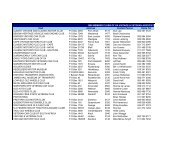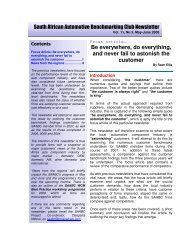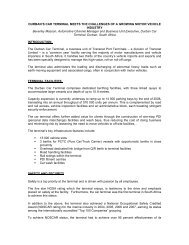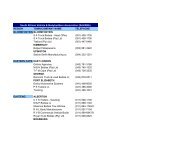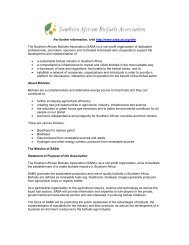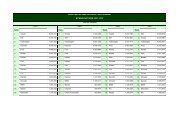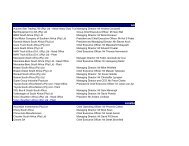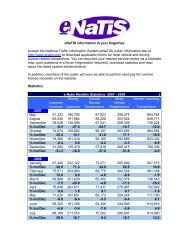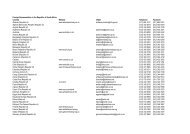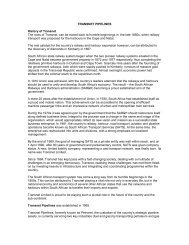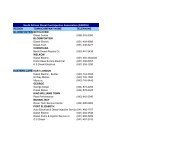Toyota South Africa Sustainability Report 2008 - Automotiveonline ...
Toyota South Africa Sustainability Report 2008 - Automotiveonline ...
Toyota South Africa Sustainability Report 2008 - Automotiveonline ...
You also want an ePaper? Increase the reach of your titles
YUMPU automatically turns print PDFs into web optimized ePapers that Google loves.
<strong>Sustainability</strong> <strong>Report</strong>_14-10-<strong>2008</strong>:Layout 1 10/14/08 2:45 PM Page 37<br />
A review of all EAP cases since 1995 revealed that over 70% of people that made use of<br />
EAP’s services remain in service. The functioning of EAP has been changed to fully take<br />
into account on-site conditions. Making use of Careways staff, we now employ six full<br />
time social workers, allocated to specific divisions. The social workers therefore become<br />
accustomed to the issues within <strong>Toyota</strong>, and within each specific division allowing for<br />
more effective interventions where needed. One of the major benefits of being in<br />
partnership with the Careways Group is the fact that employees now also have access<br />
to telephone counselling, making it easier for employees to get help.<br />
EAP maintains its community outreach programme. On a monthly basis, <strong>Toyota</strong> EAP<br />
staff go into the community, and using arts and music, draw people to attend functions<br />
at which current problems are highlighted. This issue of most concern currently is<br />
personal finances.<br />
HIV/AIDS, Tuberculosis and Substance Abuse<br />
The impact of HIV/ AIDS on employees, their families and the community is of critical<br />
concern to <strong>Toyota</strong>. In recent years extensive voluntary HIV testing and counselling<br />
services have been offered to employees along with formal hospice and home-based<br />
care facilities. This campaign is proving to be hugely successful, in that the number of<br />
deaths and the number of disability claims relating to HIV/AIDS has declined<br />
dramatically.<br />
The uptake of voluntary counselling and testing (VCT) has been phenomenal. In 2003,<br />
only 140 people underwent VCT. In 2005, this had risen to 689. In 2007, a total of 1,578<br />
people availed themselves of this service.<br />
<strong>Toyota</strong> has successfully maintained the public private partnership with government in<br />
the provision of anti-retroviral (ARV) medication to HIV positive uninsured employees.<br />
There has been a steady uptake in enrolment on the ARV programme, and there are<br />
instances where people who were on disability leave are now back at work and fully<br />
productive.<br />
There is a very strong Tuberculosis (TB) management programme at <strong>Toyota</strong>. Treatment<br />
has been introduced on site using the Direct Observed Treatment Shortcourse (DOTS)<br />
programme, where medical staff observe people taking their medication for TB.<br />
Intermittent or inconsistent taking of TB medication results in increasing incidence of<br />
extremely drug resistant (EX-DR) TB. The current cure rate in <strong>Toyota</strong> is very high; the<br />
target is 80% and the site currently records an even higher success rate than targeted.<br />
One key tool in the medical arsenal is to expose the linkage between HIV and TB, so<br />
that TB patients are encouraged to be tested for HIV.<br />
Another hugely successful programme has seen a massive reduction in substance<br />
abuse. With the cooperation of Unions, random gate tests were implemented, and if<br />
workers are found to be under the influence of drugs or alcohol, <strong>Toyota</strong> renders a<br />
supportive service to get these staff members onto relevant dependency programmes.<br />
The incidence of positive gate tests for alcohol has reduced dramatically.<br />
General Wellness days are being held in targeted areas, such as Purchasing, Human<br />
Resources and Finance. The uptake has exceeded expectations and stands at<br />
95%-97%. Other than basic health education, these Wellness days are being used to<br />
assess potentially more sensitive issues such as stress management at all levels<br />
within the organisation.<br />
Occupational Safety and Health<br />
Safety is an unquestionable value across <strong>Toyota</strong>. In the past two years, corporate<br />
structures were established to manage health and safety similar to the<br />
environmental structures (depicted in the Governance section). We have concentrated<br />
on company wide risk reduction activities – Sou-Tenken, aimed at preventing “Stop 6”<br />
type injuries (caught/pinched by machine, contact with heavy object, contact with<br />
vehicle, contact with heated substance, falling from height, electric shock). This<br />
process, depicted in the flowchart below, was started in December 2006. The initial<br />
steps in the process are proactive, where plants are required to identify hazards and<br />
implement effective countermeasures. The effectiveness of this process is evident in<br />
the graphic alongside, in that the more hazards that have been identified, the fewer<br />
the related incidents.<br />
Fatalities<br />
Despite our safety efforts, we report with sincere sorrow the deaths of two people on<br />
<strong>Sustainability</strong> <strong>Report</strong> <strong>2008</strong> 37



